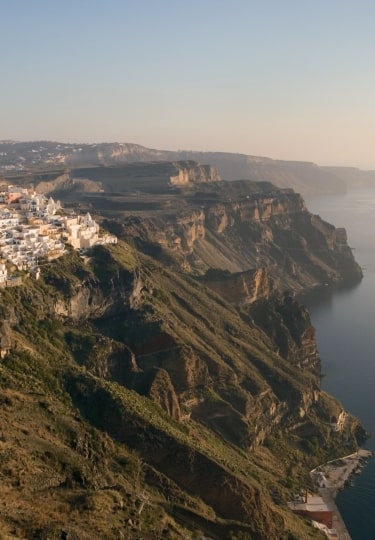Two of the main towns on the island of Santorini are the capital, Fira, and the delightful village of Oia, some six miles to the north. Both have their unique charms, so the question should not be “Oia vs Fira, which is best?”, but rather, “Should I visit Fira or Oia first?”
One thing is for certain—whichever comes first in your choice of Oia vs. Fira, you will not be left disappointed. A visit to these iconic towns of Santorini is a win-win situation whichever order you do them in.
Location

Oia
Arriving in Santorini reveals one of the most iconic sights in the whole Mediterranean: the sunken volcanic caldera with its two lava islands, Nea Kameni and Palea Kameni, still active today, shimmering in the heat haze.
Sitting on the towering cliff tops of the island’s west coast around 1,000 feet above, Santorini’s sugar cube houses and blue-domed churches that have graced many a travel magazine cover reveal themselves in a social media-worthy vignette.
Oia sits at the northwestern tip of the island. Previously a tiny hamlet, it has grown over the years as tourism has increased. Around six miles down the coast lies the island capital, Fira, its houses, hotels, restaurants, and shops dominating the clifftop as though it’s been dusted with powdered sugar.
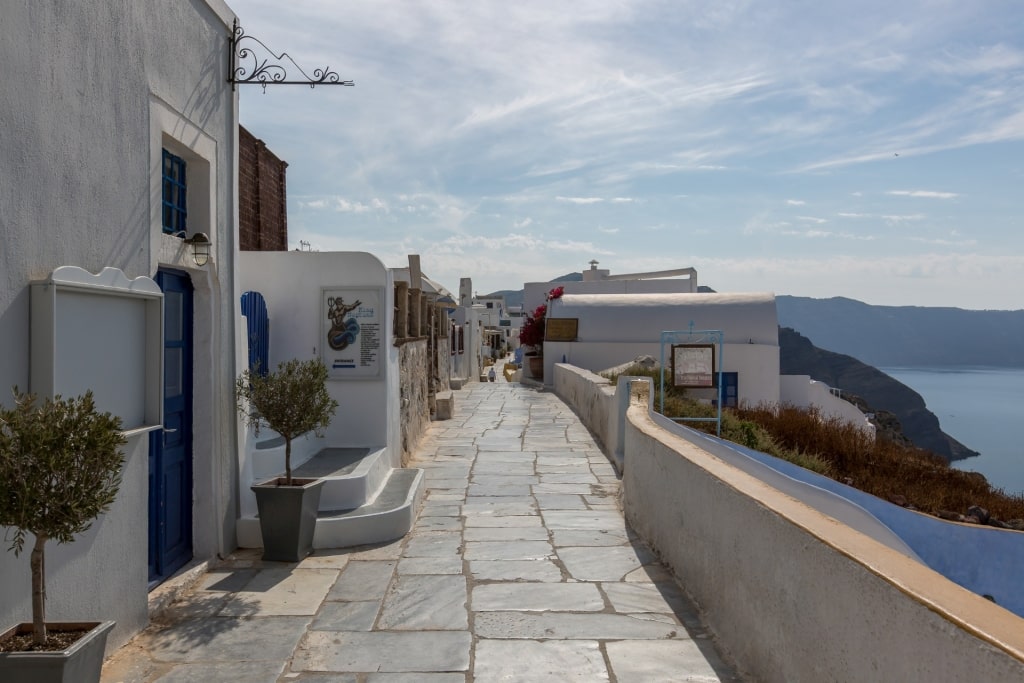
Oia
Getting between the two is relatively easy whether you choose to visit Fira or Oia first. They are so close that both can be visited in a day with taxis and buses regularly making their way between the two. If time and heat allow, the best way to see both of Santorini’s two key towns in one day is to take the clifftop walk between the two.
This meandering path, around six and a half miles long, snakes along the clifftop, each corner unveiling another incredible view. As an added bonus, the path also takes in Imerovigli, another iconic town on Santorini’s west coast. Be sure to wear sturdy walking shoes and carry plentiful water if taking the walk; in high season it can be blisteringly hot here.
Views

Fira
When it comes to which has the best views in the Oia vs. Fira debate, it’s a close call with everyone having their own favorite. Part of Oia’s tourism revival is its successful marketing as being home to the best sunsets in the Mediterranean.
Every evening people take the trip from around the island to join residents and those staying here as they “ooh” and “ahh” as the fiery sun dips below the horizon. It’s one of the island’s iconic experiences and cameras and phones click away in unison.
Oia is also where you’ll get that famous shot of the blue-domed church with the cliffs of the caldera in the background.
From Fira, the vistas are equally as impressive with the two Kameni islands and Thirasia seen over the hazy caldera. If you’ve seen images of infinity pools seemingly dropping over the edge of the cliff into the caldera below, they were almost certainly taken here.
Liveliness
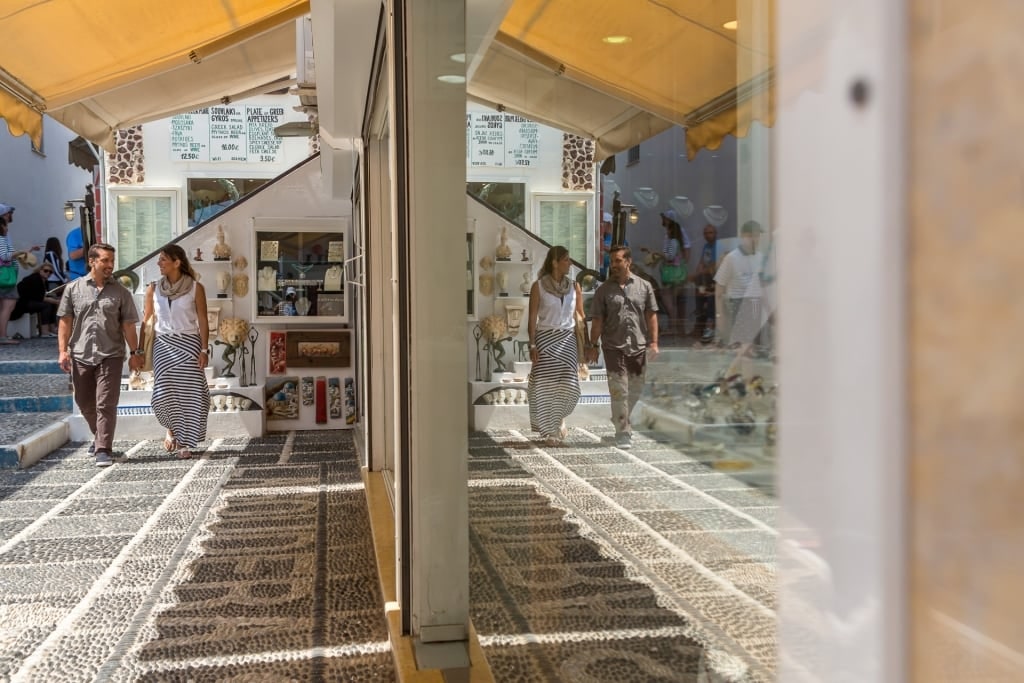
Fira
Fira positively buzzes with excitement throughout. As the largest settlement on the island, it is home to numerous bars, restaurants, cafés, clubs, shops, and more.
It’s also the capital’s transport hub with buses bringing people to and from Santorini’s new port at Athinios and sending them back out to the various resorts around the island.
Oia feels more spacious and laid-back with an overall more relaxed atmosphere. At least outside of the peak sunset hours, it’s the kind of place you’d visit to get in a spot of quality R&R.
Things To Do

Santorini Cable Car
Fira’s hive of activity means visitors are never short of things to do. Aside from the walk between the two starring towns, a great way to get a better feel for its setting is to take the tortuous walk down the winding cliff path that leads to the old port at sea level. It’s quite the trek as there are more than 600 steps, but there are alternatives.
If you’ve seen images of people riding donkeys and mules up the hill, they would likely have been shot here. Operators work under stricter animal welfare regulations nowadays and the mules are still here, although some visitors have mixed feelings about riding them.
You can always take the Santorini Cable Car, which offers a scenic ride up and down, but bear in mind that the lines are long in peak season.
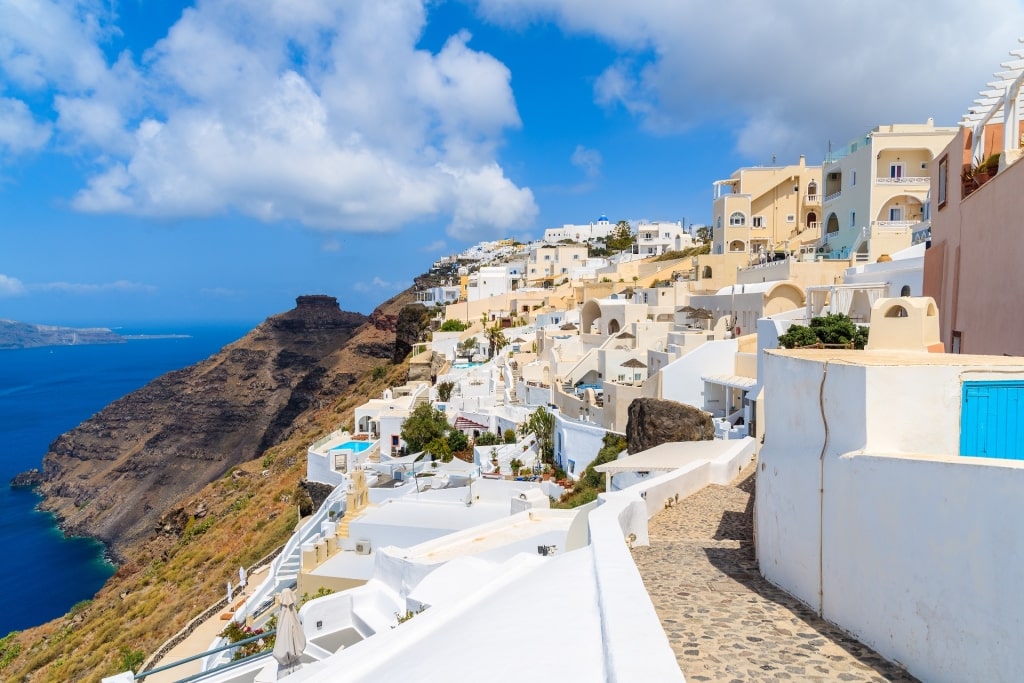
Firostefani Central Square
Back in the town itself, its heart is Theotokopoulou Main Square, a cobbled central gathering place surrounded by tavernas and other eateries. Slightly to the north, Firostefani Central Square has a similar look but a less busy feel, given its location out of the hustle and bustle of the center.
Fira also offers the chance to dabble in culture thanks to the Museum of Prehistoric Thera and the Santorini Folklore Museum, which offer excellent insights into the island’s past.

Three Bells of Thira
There are more than 1,200 blue-domed churches across the island with some 200 of them in Fira alone; it’s often said there’s one church for every family on the island.
Several of them are worth seeing, including the Greek Catholic Three Bells of Thira, which has incredible views; the Cathedral of Saint John the Baptist; and the Church of Agios Gerasimos.
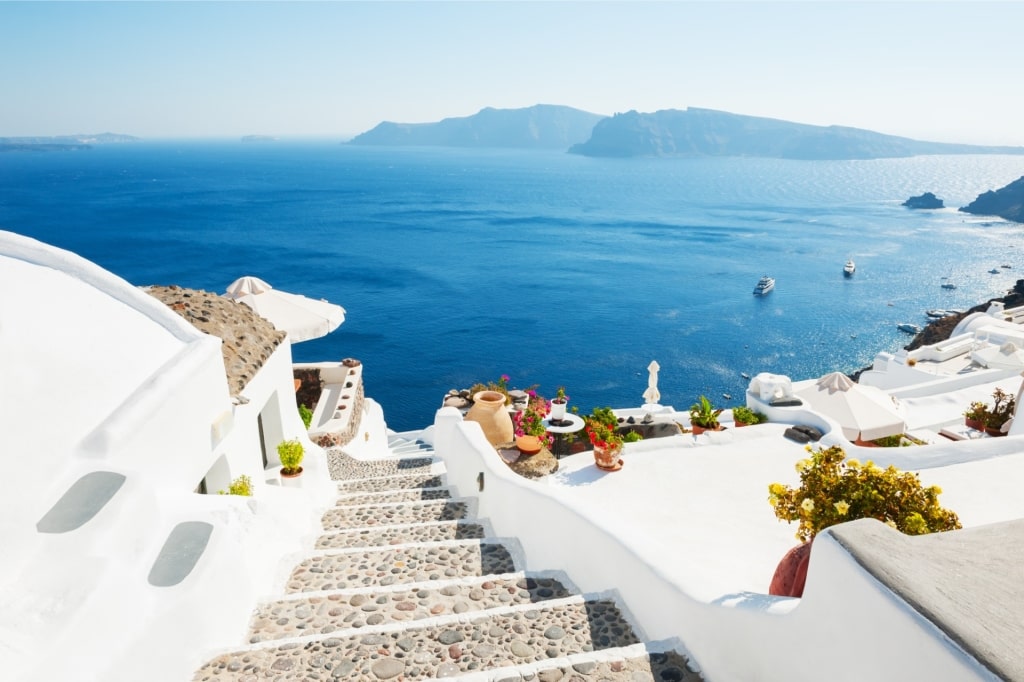
Oia Steps
When it comes to choosing sites in Fira or Oia, the former certainly has a greater number, but there’s still lots to do in Oia. As in Fira, you can walk down to the water’s edge in Oia: here there are 278 steps winding their way down the 400 or so feet to Ammoudi Bay.
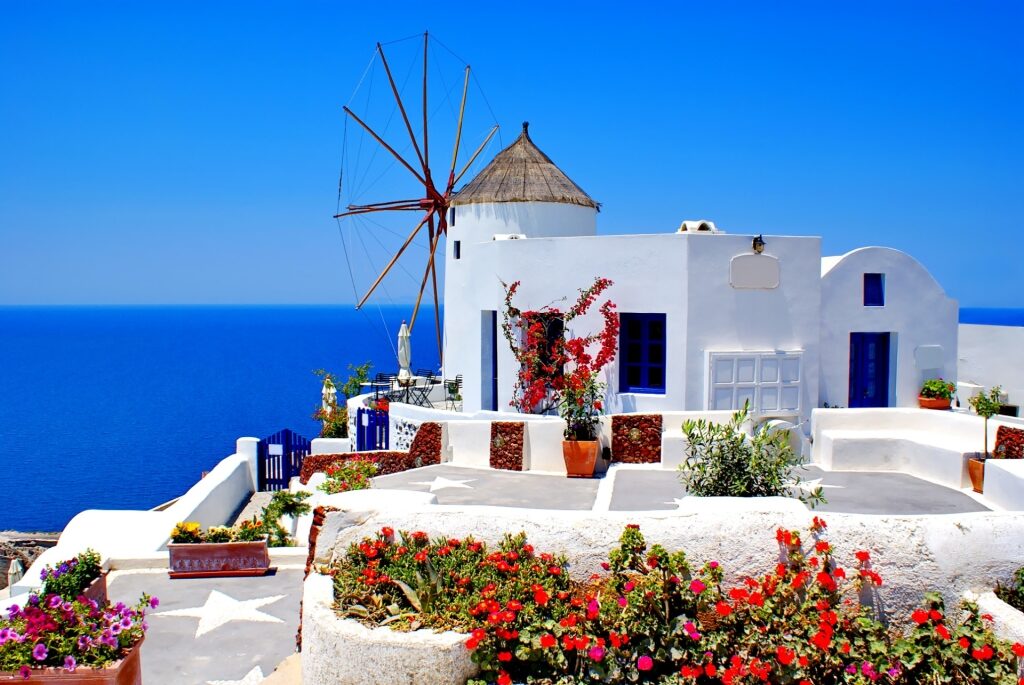
Windmill of Oia
The town’s Venetian-era castle, Agios Nikolaos, is named after a church carved in the rock there. Not only is it one of the island’s most historic places, but also a great spot to see those sunsets, as is the Windmill of Oia which makes for great images against the darkening sky.
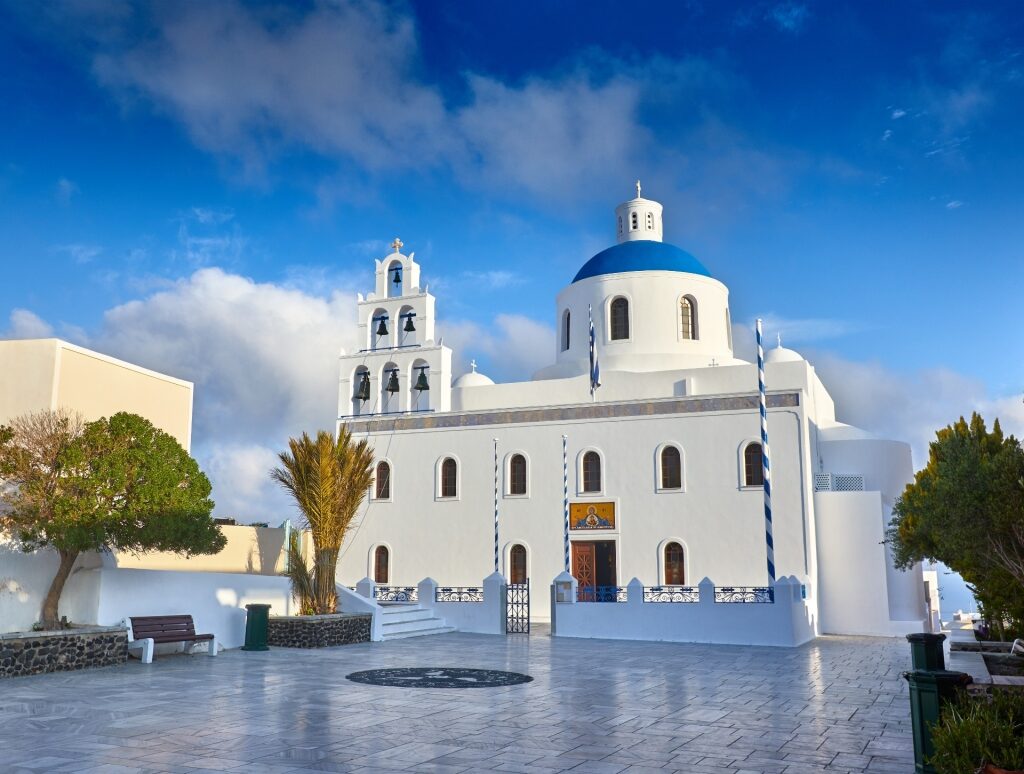
Church of Panagia Platsani, Oia
Oia is also home to the iconic churches that make it one of the most beautiful places in Greece. Make sure to check out the Church of Panagia Platsani. Originally in the Venetian castle, it was totally destroyed in the 1956 earthquake and was rebuilt outside the walls in its current location on the main square. It consists of five domes, the largest of which is painted blue and has a lovely gilded mosaic above the main door.
Those looking to find out more about the village’s history can delve into the Naval Maritime Museum. Set over two floors in a former captain’s home, it offers an insight into the island’s maritime past with a selection of maps, lamps, anchors, pulleys, and other equipment.
Places to Swim
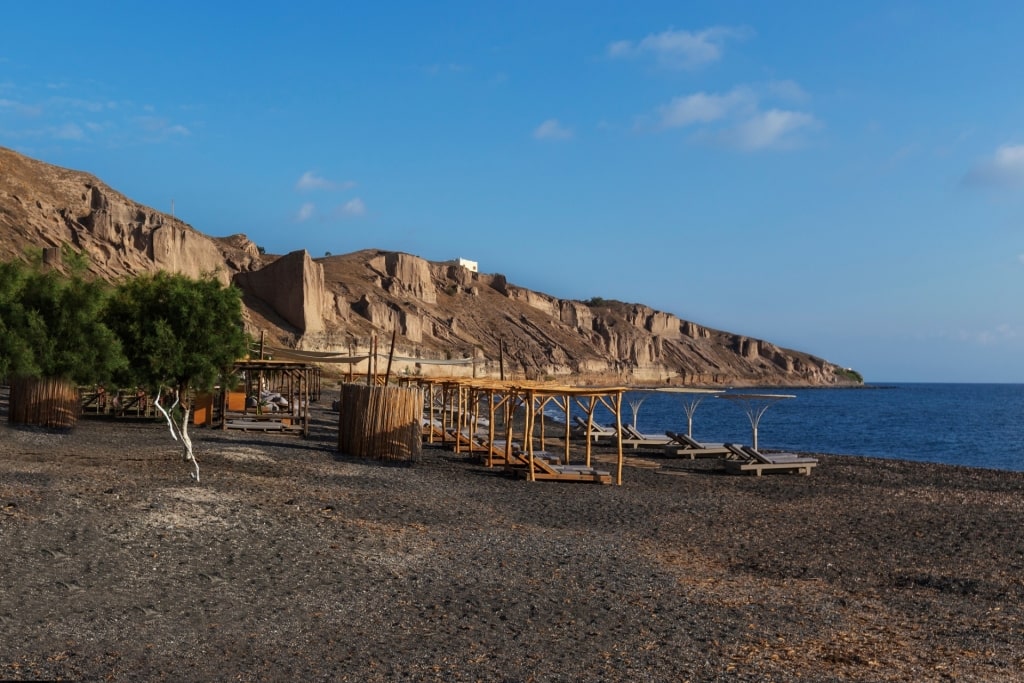
Exo Gialos
While Santorini is known as one of the best Greek islands for beaches, most of them are on the opposite side of the island where there are fewer cliffs. From Fira town, you can easily jump on buses or grab a taxi to beaches such as those at Kamari and Perissa.
The closest beach to the town itself is just 2.5 miles east at Exo Gialos. Its proximity to the capital means it is usually quite quiet as many prefer to seek out the more famed beaches above—which is lucky for those who venture here.
This pretty beach in Santorini features a mix of sand and pebbles with some quite stunning rock formations around it. There are organized facilities here, too, with a beach bar offering umbrellas and sunbeds for rent.
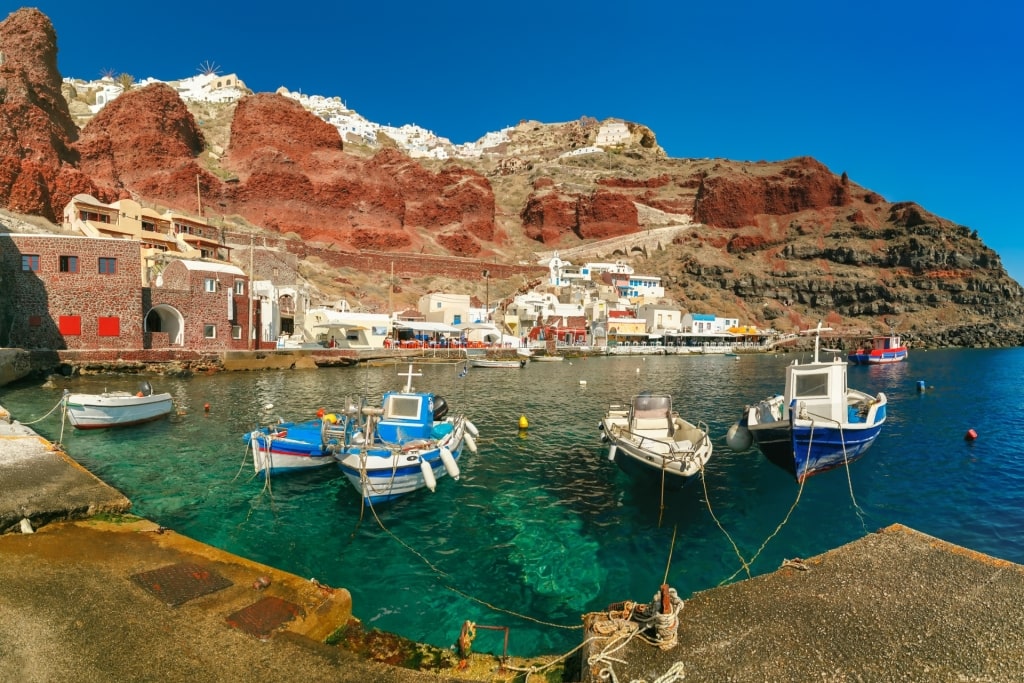
Ammoudi Bay
In Oia, people can swim at Ammoudi at the foot of the Oia Steps by jumping in off the dock. The waters here can be quite deep and this is advised for strong swimmers only.
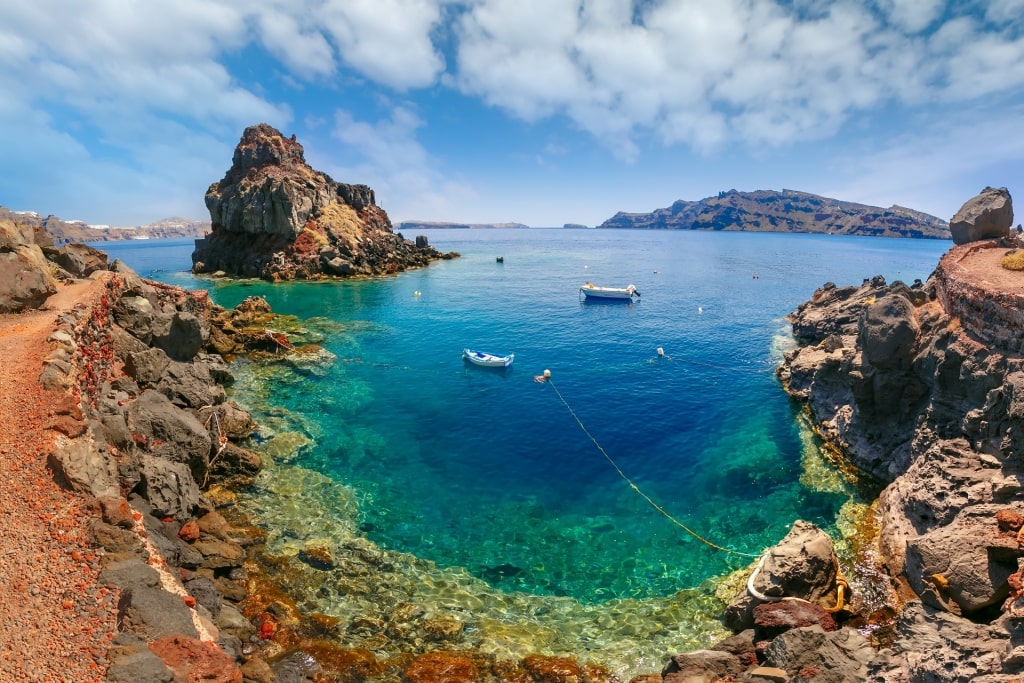
Armeni
Another set of some 300 steps from the town lead to a small beach at Armeni—formerly the town’s port—south of the main settlement. The pebble beach here may not be the largest but is quite dramatic thanks to large black and red rocks either side. Facilities include a small, traditional taverna but there is no sunbed or umbrella rental.
Romance
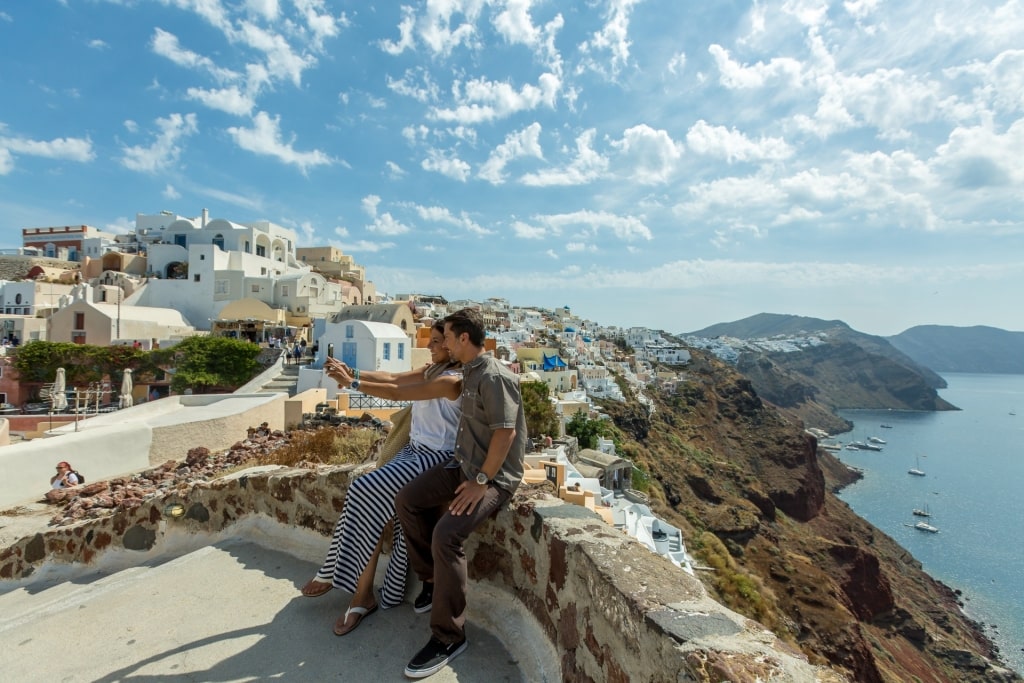
Oia
Few islands in Greece have the romance of Santorini, and loved ones can share special moments whether visiting Oia or Fira.
Oia is one of the most romantic places in Greece, offering a laid-back atmosphere perfect for couples seeking solitude. The romantic walks around the town are second to none.
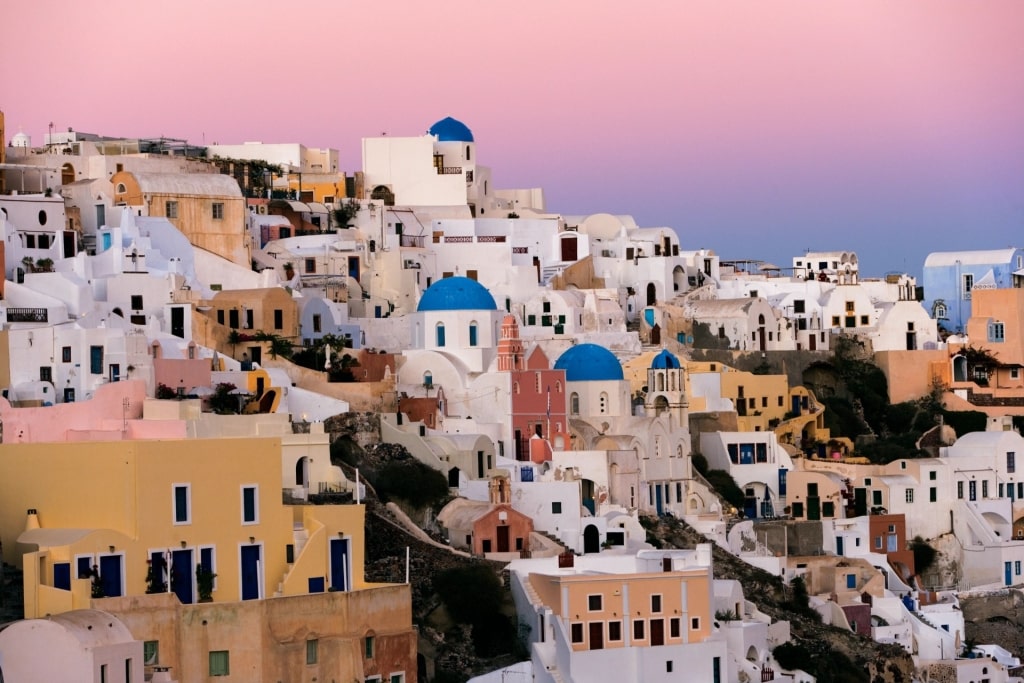
Oia
Those mythical sunsets every evening have also seen many a marriage proposal, especially in the shoulder seasons when the island is less busy—and the village has been voted one of the most romantic places in the world in many surveys.
While it’s true Fira is the more buzzy of the two, it’s also a great spot for couples. Relaxing with a cocktail or glass of wine in one of the many bars overlooking the caldera is one of the most indulgent of things to do on the island.
Barely a summer’s eve goes by without a happy bride and groom emerging smiling from one of the town’s iconic churches and smaller chapels.
Shopping
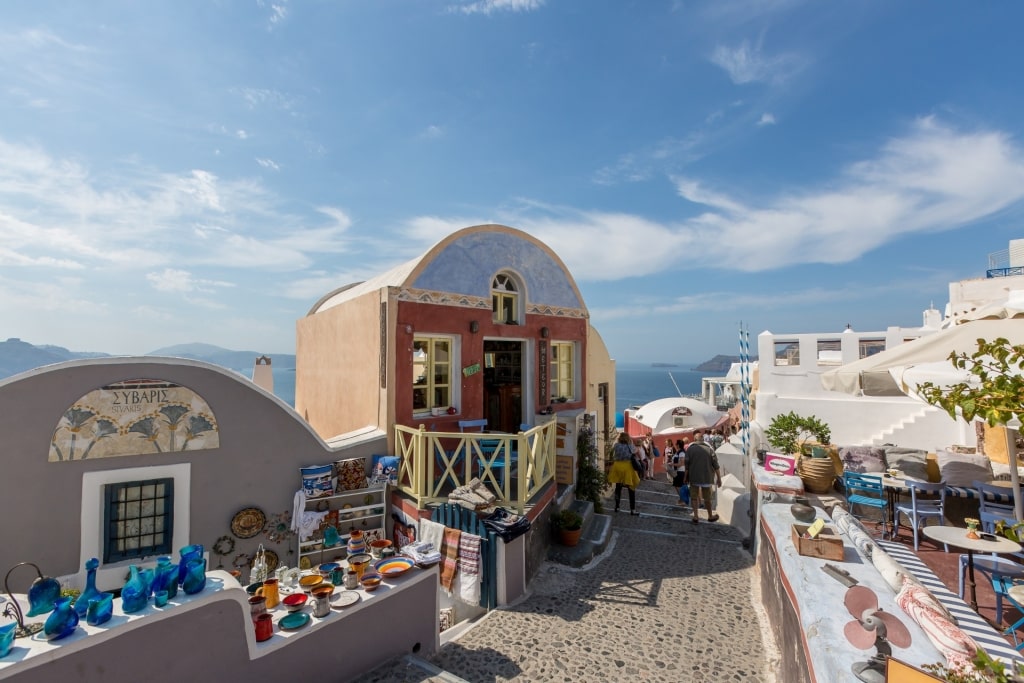
Oia
The winding streets of Fira town are great for browsing and picking up Greek souvenirs or a special present for a loved one. For those looking to splash the cash, “Golden Street” is home to the island’s best gold and silversmiths, including Caldera Jewellery, Ilias Lalaounis and Greco Gold.
Other items that are great to take home include Santorini wine, which has a unique terroir thanks to the island’s volcanic nature, olive oil, Greek honey, and almost anything you can think of sculpted in the island’s classic blue-and-white colors.
Oia has a similar range of traditional shops, but there are also a number of higher-end boutiques offering pieces for both men and women by Greek fashion designers. Look out for Wanderlista, It’s A Beautiful Day, and Speira.
Read: Best Things to Do in Greece
History
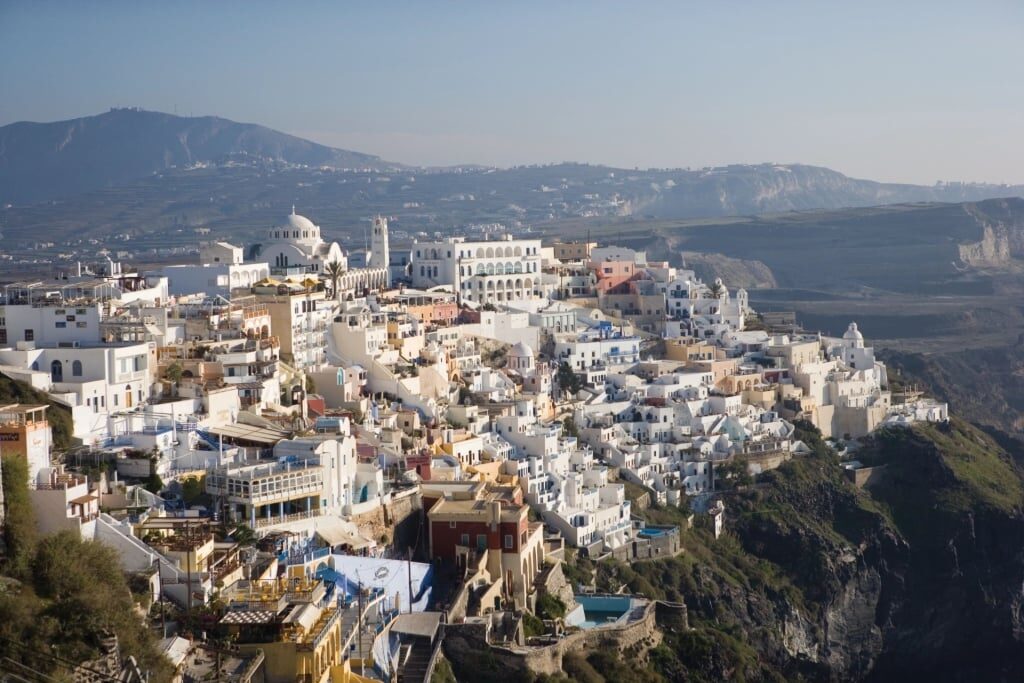
Fira
Santorini, or Thera as it is officially known, has been inhabited at least since the Bronze Age and was subjected to one of the largest volcanic eruptions in history that occurred some 3,600 years ago at the height of the Minoan civilization.
That eruption shaped the beautiful island—geographically at least—as we know it today. It left the main island, its sister island, Thirasia, across the caldera, and the two lava islands with their volcanic craters and hot springs resulting from the geothermal activity below.
A subsequent violent earthquake in 1956 destroyed many homes across the island and these have since been rebuilt or replaced.
Fira—also somewhat confusingly known as Thera—rose from its status as a medieval fort and one of the island’s ports to became the capital in the late 18th century when the former capital, Skaros, was abandoned.
Houses here consist of two styles. Cave houses, which were formerly for the lower class, though many of them have now been converted to high-end bars, restaurants, hotels, and urban houses, the more traditional cubist homes for the upper class.
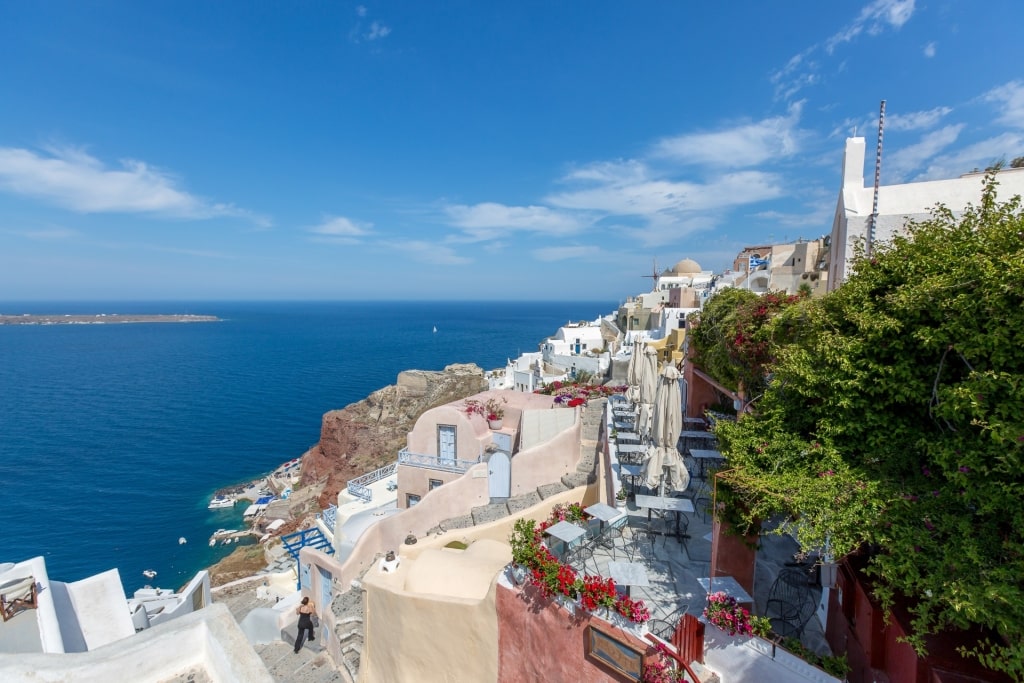
Oia
Ancient Oia was originally called Apano Meria, or the upper side, and residents are still known colloquially as Apanomerites.
Inhabited since at least since the 13th century when the island was under Venetian rule, it became an important port with a merchant fleet that had strong ties with both Egypt and Russia in the late 19th century. This prosperity led to a number of captains’ mansions which still dot the mountain village.
The demise of the fleet as trading conditions changed in the 20th century saw Oia return to a sleepy hamlet before being revived by the tourism industry from the 1960s onwards.

Oia
Plan your next escape to the Greek Islands aboard a cruise to Santorini with Celebrity Cruises.
